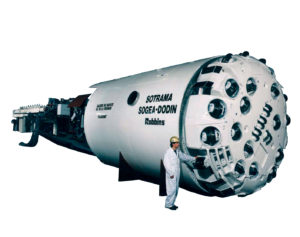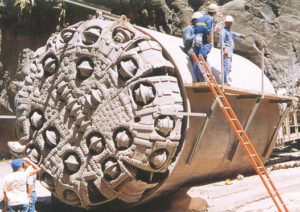![65 Years of Innovation and Experience [default]](https://www.robbinstbm.com/wp-content/uploads/2017/04/Side-Bar-Blue-Blocks_70-Years.jpg)
A Solution for Every Condition: Search our Project Database
Project Map
FEATURED PRODUCT: CROSSOVER MACHINES
Our History
A Legacy of Innovation
Information 24/7
News & Media
Insights in the Industry:
Read the Robbins Blog
 The La Réunion Irrigation Project is located in a French territory in the Indian Ocean. The project consists of a system of tunnels that irrigates sugar cane crops and provides water to the general population on the island’s west side. Underground tunnels transport water from three sources on the island’s water-rich east side to more arid western areas. Several organizations financed the project, including the European Community, the French Government, the Réunion Department and the Réunion Region.
The La Réunion Irrigation Project is located in a French territory in the Indian Ocean. The project consists of a system of tunnels that irrigates sugar cane crops and provides water to the general population on the island’s west side. Underground tunnels transport water from three sources on the island’s water-rich east side to more arid western areas. Several organizations financed the project, including the European Community, the French Government, the Réunion Department and the Réunion Region.
In 1990, French Contractor SOGEA awarded the TBM contract to Robbins. The company built a 4.3 m (14.1 ft) diameter Single Shield tunnel boring machine (TBM) for the boring of Tunnels I and II. Tunnel I carries the combined inflow of water from Tunnels II and III and river water from the Rivière de Galets. This water is then transported 8.6 km (5.3 mi) to a reservoir on the western side of the island. Tunnel II is a short 2.4 km (1.5 mi) tunnel that carries the water from Tunnel I via siphon under the Rivière de Galets.
Geology in all three La Réunion tunnels consisted mainly of olivine basalt. Faults in the region have created brecciated zones of blocky rock combined with mudstone and clay. Water inflows and alterations are typical of these zones.
Robbins designed the Single Shield TBM to meet the unique challenges of abrasive rock and water inflows in the two tunnels. The machine’s cutterhead featured five buckets and 29 recessed back-loading 17 inch (432mm) disc cutters mounted for safe changing from the rear.
Six 160 kW (214.5 hp) motors powered the cutterhead and generated over 1,297,547 N-m (960,177 lb-ft) of torque. The two-speed articulated cutterhead increased direction control and stability in blocky rock. Robbins also added a pumping system to the TBM and seals to the cutterhead and shield. These added features prepared the machine for boring through basalt with heavy water inflows.
The TBM’s ventilation system included a 900 mm (35.4 in) diameter fan, an air duct, an air conditioning unit and a cassette system control-mounted on the TBM back-up.
 In Tunnel I, the TBM met its first challenge at the outset. The initial 500 m (1,640.4 ft) of the drive consisted of hard volcanic debris, water, and blocky rock. The TBM encountered two extensive zones of poor rock with maximum water inflows into the tunnel of approximately 45 liters (11.9 gallons) per second. The crew and Robbins field service engineers dealt with these problems with several on-site modifications. One of these modifications involved removal of the extendable cutter to allow installation of an extra bucket in the face. This extra bucket increased the number of openings and improved face cleaning operations, leading to more efficient tunnel boring.
In Tunnel I, the TBM met its first challenge at the outset. The initial 500 m (1,640.4 ft) of the drive consisted of hard volcanic debris, water, and blocky rock. The TBM encountered two extensive zones of poor rock with maximum water inflows into the tunnel of approximately 45 liters (11.9 gallons) per second. The crew and Robbins field service engineers dealt with these problems with several on-site modifications. One of these modifications involved removal of the extendable cutter to allow installation of an extra bucket in the face. This extra bucket increased the number of openings and improved face cleaning operations, leading to more efficient tunnel boring.
During boring, the wear on the cutter assembly hubs was severe due to the soft but highly abrasive olivine basalt. This problem was partially resolved by the tunnel crew who decided to hardface the hubs. Cutter ring wear varied from 300 hours of life for center cutters to 50 hours of life for gauge cutters in the most abrasive conditions.
Despite difficult geologic conditions, the TBM continued to make significant advances and finished on schedule. The machine advanced at an average rate of 4.46 m (14.6 ft) per hour. An average workweek consisted of five days in three shifts, totaling 1,989 machine hours.
The TBM achieved breakthrough in Tunnel I on September 17, 1992 and then underwent a routine rebuild and testing for Tunnel II. The machine began boring the second tunnel in 1993 and finished in six months.

 Close
Close